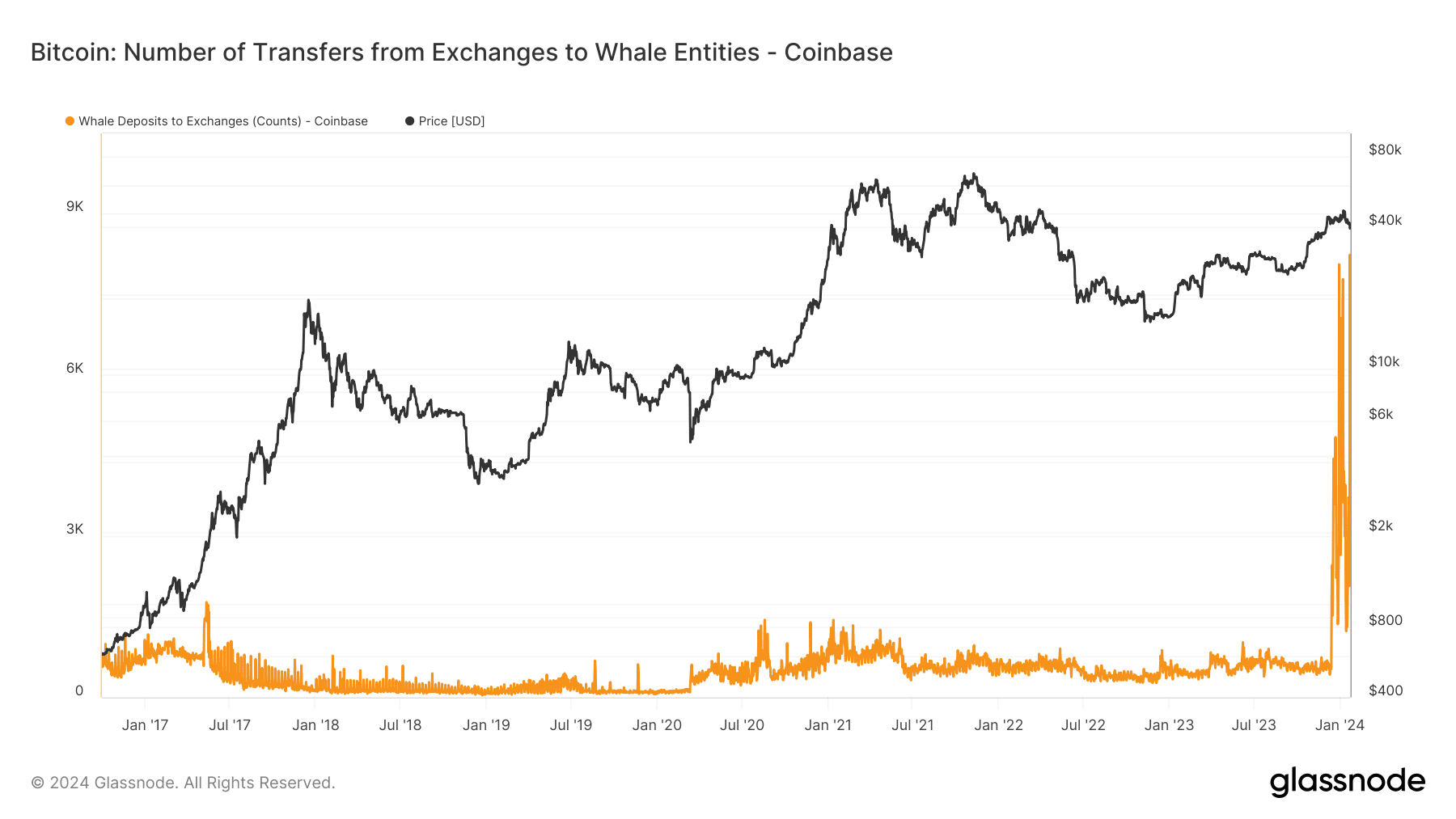News - Price drop after the ETF - A long correction or "bullish selling"?
By
Price drop after the ETF - A long correction or "bullish selling"?
Massive outflows from the Grayscale ETF GBTC are putting pressure on cryptocurrencies. What's behind it and what can we all expect in the coming period?
Had it not been for Grayscale, the launch of the Bitcoin ETF would likely have been the best ETF launch ever - as measured by the trading volume and volumes BlackRock and Fidelity collected in the short term. That this historic moment has now turned into a "sell the news event" is largely due to the huge sales of the GBTC Bitcoin fund. Or rather, Grayscale's clients, who we now also know sold FTX shares in the past year. Even a year and a half after the collapse, the FTX ghost seems to haunt investors. In doing so, they are spoiling the fun of the bulls.
To make matters worse, more and more bitcoins are being transferred from whales (wallets with more than 1,000 BTC) to exchanges, indicating major sell-offs by large investors. What for some is only part of a small correction appears to others to be the beginning of a longer weakening of the price. So has the big Bitcoin Party of 2024 already been canceled or is this the "bullish selling" phenomenon? An overview and classification of Grayscale, whales and other aspects.
GBTC bleeds, BlackRock devours BTC
The world's largest asset managers, including BlackRock and Fidelity, and their clients are currently devouring every bitcoin. The huge influx of new investors has so far been able to absorb the huge outflow from Grayscale. This is according to data from Bloomberg analyst James Seyffart. According to this data, Grayscale lost USD 3.96 billion in BTC on Jan. 23, while BlackRock and Co. posted a profit of USD 4.94 billion.
Update for the #Bitcoin ETF Cointucky Derby.
— James Seyffart (@JSeyff) January 24, 2024
$515 million came out of $GBTC yesterday for a total of $3.96 billion in outflows since converting to an ETF. Newborn 9 saw +$409 million flow in. Net outflows in total for yesterday were -$106 million. pic.twitter.com/gzymMHHua8
This represents a net gain of approximately $983 million in Bitcoin inflows into all ETFs in the "Cointucky Derby", as the Bloomberg analyst calls the spectacle. And yet prices are falling. One reason may be that inflows and outflows were not evenly distributed. For example, all ETFs combined saw net outflows of several hundred million US dollars on some days. Because of the cash redemption model, which the SEC made a condition of ETF approval, there is also a lag (up to two days) between the purchase/sale of ETF shares and the purchase/sale of Bitcoin behind them. In other words, even on days of inflows, the aftermath of the previous day's sales can depress spot prices. The culprit seems to have been identified: Grayscale and the GBTC fund. Or is there more behind it after all?
Gasoline on the crypto fire
The theory is simple: Grayscale's significantly higher ETF fees and the fact that investors in the fund had a huge arbitrage opportunity just a few months ago and are now taking bigger profits is causing a massive outflow. In recent weeks, on-chain data from Arkham Inelligence showed how Grayscale sent batches of several 10,000 BTC to Coinbase shortly before the US market opened. However, as Andre Dragosch, head of research at ETC Group, notes on X, this is only part of the total 283,000 BTC received on Coinbase since the ETF launch. The following Glassnode chart impressively illustrates the huge increase in BTC on the U.S. exchange.
According to Dragosch, Grayscale's outflow accounted for 76 percent of all BTC whale transactions at its peak. On some days, however, this was only two percent, meaning that a host of other sellers were selling Bitcoin. Mainly whales with more than 1,000 BTC in their wallets. He calculates that for every percent increase in terms of ETF inflows, there is a 0.41 percent drop in the price of Bitcoin. So we can conclude that it is not just the GBTC fund that is responsible for the recent price correction. The massive profit taking by some whales is also causing red numbers and volatility in the markets. Once the downward spiral gets going, the rest will take care of itself.
However, the outflow from GBTC might be a "short-term phenomenon" could be, according to Dragosch. Given that at this rate, the fund "would run out of bitcoins within 37 days", he thinks the outflow is likely to slow. This can already be seen in the data, as Eric Balchunas, also an analyst at Bloomberg, revealed on X on Jan. 24. Dark clouds are also forming from another direction.
The aftermath of Mt Gox.
The trustees of bankrupt crypto exchange Mt Gox could not have chosen worse timing. Rumors that the exchange was preparing to pay out 142,000 BTC to creditors followed in the midst of already poor market sentiment. However, the rumors so far were based on unverified emails to alleged victims. There are also differing opinions on the actual effect of these payouts. Why? The process is constantly being delayed. Therefore, sales resulting from Mt.Gox's payouts are unlikely to materialize until they do. Still, investors are wary.
But macroeconomic events could be much more the reason people take their profits. At least Arthur Hayes, founder of Bitmex, is convinced of this. In his latest blog post, he interprets Bitcoin's price movements as an indicator of the dollar's soon-to-be collapsing liquidity. And points to the divergence between Bitcoin and the S&P500 stock index.
According to Hayes, liquidity may be temporarily withdrawn from the market in the coming weeks and months. According to him, the new US government bond program, to be announced on Jan. 31, will be decisive. If bond issuance shifts from short-term to long-term, the crypto and stock rally would run wild. Bitcoin is already pricing this in. The S&P500 and other TradFi indices, which recently reached a new all-time high, should prepare for a "unpleasant surprise", says Hayes.
Y has $SPX and $BTC stopped moving up together post US BTC ETF launch?
— Arthur Hayes (@CryptoHayes) January 22, 2024
Both are love more $ liq, which one is right about the future?$BTC is telling us that there are hiccups ahead for $ liq, next signpost is 31st Jan US Treasury refunding annc. pic.twitter.com/CSDvFp4QKu
The Bank Term Funding Program (BTFP), the Federal Reserve's rescue program for the US banking sector, also expires in March. The central bank confirmed this in a statement yesterday. Hayes thinks this withdrawal of liquidity will put the U.S. banking sector back into a new "mini-crisis" would plunge, leading temporarily to strong sell-offs in the markets. He then predicts that Bitcoin would bottom out at $30,000 to $35,000. Indeed, the looming financial crisis would prompt the Federal Reserve to reinstate stimulus measures, as Hayes predicts. The past shows that Bitcoin and other cryptocurrencies usually benefit in the long run.







